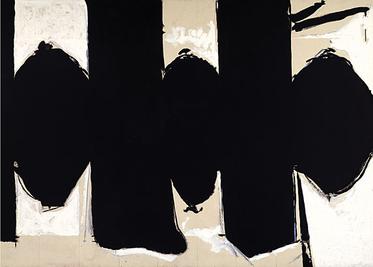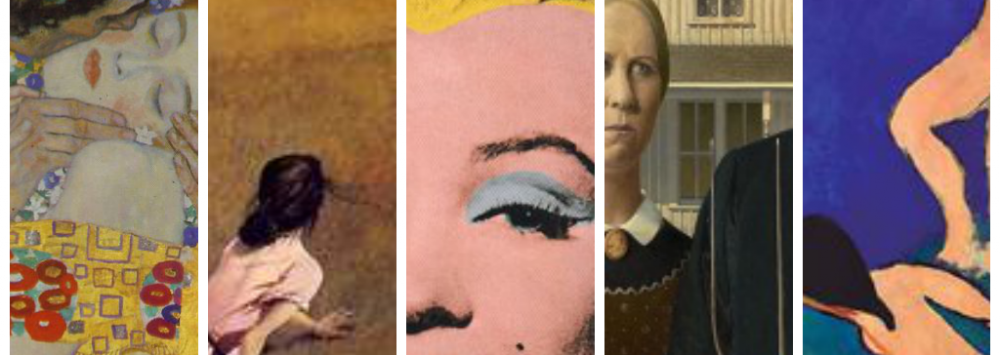
Motherwell Himself
Africa Suite: Africa 2, 1970

Figure Before Blackness, 1960

Frontier #6, 1958
Biography
Robert Motherwell III was born January 24, 1915 in Aberdeen, Washington to Robert Motherwell II and Margaret Hogan Motherwell. Motherwell’s father was president of Wells Fargo Bank, so he and his family lived comfortably. However, Motherwell was very sickly in his youth, suffering from severe asthma. For this reason, Motherwell and his family moved to California, known for its clean air, and they would stay here for the remainder of his childhood. Between the years 1932 and 1937, Motherwell studied painting at the California School of Fine Arts in San Francisco and received a B.A in philosophy at Stanford. His father pushed him to continue his studies at Harvard University to ensure he made a decent living. From here, he went to Columbia University, where he met and began studying under modern art historian Meyer Schapiro in 1940. It was Schapiro who introduced Motherwell to the Parisian Surrealists Max Ernst, Marcel Duchamp, and Andre Masson. Also, Schapiro influenced Motherwell to fully devote himself to his artwork over academia, despite his father’s urgings. Motherwell married three times and fathered two children before settling down with Helen Frankenhalter in 1958, with whom he was married until 1971. On July 16th, 1991, Motherwell passed away of old age in Provincetown, Massachusetts.
Influence and Style
Motherwell’s childhood spent in the hills of California greatly influenced his appreciation for broad space and bright colors, both of which are present in his abstract paintings, such as Among the youngest of the Abstract Expressionists, or New York School artists, Motherwell worked alongside the likes of Philip Guston, Willem de Kooning, Jackson Pollock and Mark Rothko. Besides Meyer Schapiro, another prominent teaching figure in Motherwell’s life was Roberto Matta, whom Motherwell met on a Mexican cruise in 1941. While Schapiro connected Motherwell with the Parisian Surrealists, Matta introduced him to their technique– the autonomy of their paintings and their process of abstract doodling. Using what he learned from his philosophic studies at Stanford and lessons from Matta, Motherwell created his own theory of automatism.
“What I realized was that Americans potentially could paint like angels but that there was no creative principle around, so that everybody who liked modern art was copying it.”
In his theory, Motherwell completely altered the American modern artist’s point of reference. In the early 1940’s, he proposed that American artists should change their course of action from imitating the creative works of Picasso and other European modern artists to pioneering their own stylistic ingenuity. It is for this that many accredit Motherwell as the one who spearheaded the rise of Abstract Expressionism.
From 1948 to 1967, Motherwell produced over 100 paintings as part of what he called the Elegy to the Spanish Republic. In the majority of these works, he made rough black ovals the center of attention to represent lamentation of post Spanish Civil War society. He said they were meant to “represent the dead bull’s testicles.” A fine example of this trend can be found in Elegy of the Spanish Republic, No. 57, where he creates a row of these ovals interrupted by a bold black vertical rectangle.
From 1967 until the late ’70’s, Motherwell worked on a second collection he called Open Series. In these works, he used a very limited color pallet to create rough rectangular configurations, as seen in his 1969 painting Open No. 122 in Scarlet and Blue, where he illustrates the bottom half of a rough light blue rectangle on a clean red background.

Open No. 122 in Scarlet and Blue, 1969
Abstract Expressionism
Jumpstarted during the 1940’s, Abstract Expressionism put New York City on the artistic map, making it the new epicenter of the western art world over Paris. The movement consisted of a few loosely affiliated artists, each of whom made work of a generally large scale that reflected their personal stylistic preferences. While the works of Abstract Expressionism varied in style, the common thread was in their high energy and the premium the artists placed on process. All artists of this movement valued spontaneity and improvisation, however, they each wanted their compositions to make a point, which is where the line is drawn between this, Dadaism and Surrealism. While not completely abstract, compositions of Abstract Expressionism commonly took on an abstracted mode, even when the artists were depicting a realistic image.
My Thoughts
I would categorize Motherwell as a “privileged artist”, considering his comfortable upbringing and access to an elite education. In doing this, I am in no way discrediting his talent and value as an artist. What drew me into working with Motherwell were his Elegy to the Spanish Republic paintings, which remind me of the psychology tests with random ink blotches doctors will sometimes give their patients to assess their mentality. My favorite composition of Motherwell’s would have to be Red 8-11, one he painted in 1969. This piece reminded me of the conversation we had during our class about the thought and effort artists put into even their most simplistic compositions. Though Red 8-11 appears to only be a black splotch on a beige canvas, a closer look will show that there is some discontinuity in the black paint. This piece embodies the Abstract Expressionist ideals of abstract undertones with a direct purpose. Most of Motherwell’s pieces I had some trouble comprehending without his own thoughts. However, one that stuck out in this regard was Motherwell’s 1965 piece, Automatism A, which appears to be three separate brush strokes of varying consistencies– all black– on a clean white canvas. While Automatism A seems to represent Motherwell’s automatism theory of American artists’ stylistic succession from the European modern artists’ more uniform technique, it was difficult for me to see these three brush strokes as something more.

Automatism A. 1966

Red 8-11, 1969.

Elegy of the Spanish Republic 57, 1971
21st Century Comparison
Born in Hampton, Virginia in 1973, Richard Aldrich is a Brooklyn based painter whose approach towards his work is very reminiscent of Robert Motherwell and the rest of the Abstract Expressionists. Like Motherwell did, Aldrich uses a limited pallet and, through his work, evokes a balance of energy and tranquility. An especially Abstract Expressionist quality of Aldrich is his appreciation for process, playing with the concept that an artist only needs a frame to make a painting. My favorite composition by Aldrich is an untitled piece he created in 2008.It is an oil, wax painting consisting only of shades ranging from black to white. I admire it not only for its simplicity, but for the cosmetic similarities it shares with many of Motherwell’s pieces. Below are a few of his pieces, including my personal favorite, Untitled.

Untitled, 2008

Looking with Mirror Apparatus, 2008

Figure with Cape, 2008

Mother, 2012
Bibliography
Bortolami. N.p., n.d. Web. 4 May 2014. <http://www.bortolamigallery.com/
artists/richard-aldrich/>.
Guggenheim Museum. N.p., n.d. Web. 4 May 2014. <http://www.guggenheim.org/
new-york/collections/collection-online/artists/bios/1394>.
The Metropolitan Museum of Art. N.p., n.d. Web. 4 May 2014.
<http://www.metmuseum.org/>.
Modern Edition. N.p., n.d. Web. 4 May 2014.
<http://www.modernedition.com/>.
